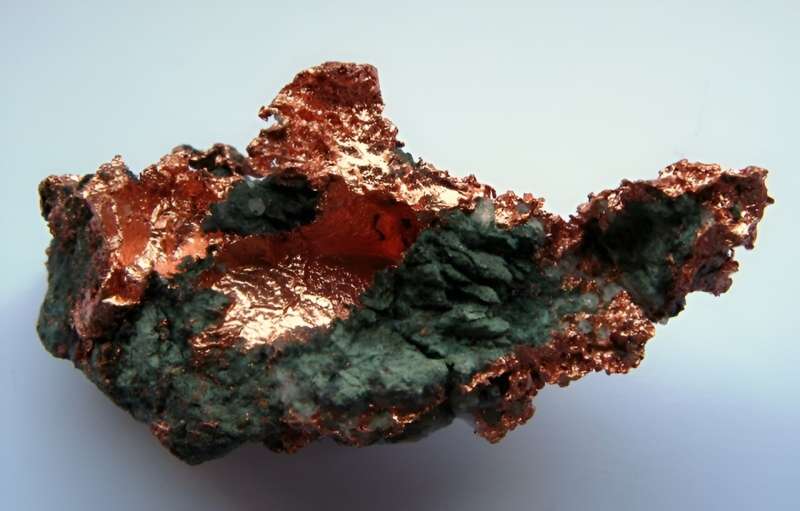This article has been reviewed according to Science X's editorial process and policies. Editors have highlighted the following attributes while ensuring the content's credibility:
fact-checked
trusted source
proofread
Conducting change: Why copper is key to a renewable future

Copper was discovered in the Neolithic Age about 9,000 years ago. It was the first metal used by humans. And we've continued to value copper ever since. The average family home contains more than 90 kilograms of copper. Every time you turn on a light, use a mobile phone or drive a car, you are relying on copper.
It might not look like anything special, but copper has amazing properties. The reddish-gold metal is malleable and can be mixed with other metals (alloys). It is the most cost-effective conductor of electricity.
Copper's connection to clean energy
The race to decarbonize our energy sector relies on having materials to make renewable and low emission technologies. Copper is an essential material in many types of clean energy. It is used for wind and solar technology, energy storage, and electric vehicles. However, these renewable energy technologies require up to five times more copper than non-renewables. While copper is 100% recyclable, we still need to find new copper reserves to meet growing copper demand.
Australia holds a substantial portion of the world's copper. We were ranked second behind Chile in 2016, according to the United States Geological Survey (USGS). Copper-rich South Australia recently declared copper a key mineral for the state, country and world as economies seek to decarbonize.
A mineral mosaic
So where does copper come from?
There are around 160 naturally occurring copper-bearing minerals. Chalcopyrite, bornite, chalcocite, and native copper (an uncombined form of copper) are four minerals often mined for their copper content. Azurite and malachite were once mined as a source of copper. Now, they are treasured as gemstones.
Don't be fooled by chalcopyrite
Chalcopyrite is the most abundant copper-rich mineral. In Australia, it is found in rock that is 1.5 billion years old. It's a mixture of copper, iron and sulfur. It is one of the three different minerals called "fools gold" because it sometimes has a yellow metallic luster.
Chalcopyrite is also a popular mineral specimen among collectors because of its colorful tarnish. Some people call it the "peacock ore"—a reference to its iridescent color which is caused by the oxidation of its surface.
Azure-blue azurite
Azurite is a copper carbonate mineral that forms in the upper oxidized zones of copper ore deposits. It has a deep azure-blue color that can vary from bright to dark. When exposed to air and water, it often shows a rainbow-like iridescence. Since ancient times, it has been used as an ore of copper, a gemstone, and a pigment. Michelangelo and Leonardo DaVinci even used it to create blue hues in their paintings.
While azurite is found in many parts of the world, Australia has produced some of the most interesting forms. In Tasmania, azurite occurs in a form known as azurite suns. These circular forms resemble the shape of the sun and are created by the compression of azurite crystals in clay.
Green with malachite
Malachite was one of the first ores used to produce copper metal.
Often found with azurite, malachite is a mixture of copper, iron, and oxygen. It has a deep green color that does not fade over time or when exposed to light. This made malachite a popular pigment for painting. Ancient Egyptians used it for tomb paintings. European painters, especially in the 15th and 16th centuries, loved the palette of greens it gave. Artists in India, Tibet, China, and Japan used it in murals, manuscripts, ceramics, and lacquerware.
Finding copper in sedimentary basins
Dr. Susanne Schmid is part of our mineral discovery team. She specializes in understanding sedimentary basins.
"Currently, sedimentary basins account for 20% of copper production worldwide," Susanne said.
Sedimentary basins form along continental margins and depressions on Earth's surface where a lot of sand, mud, and organic matter accumulate over millions of years. These sediments get buried deeper and deeper under more layers of sediments over time. Susanne works with many of Australia's Geological Surveys and industry partners, studying underexplored sedimentary basins. She is looking for clues to where copper and other metals may be found.
"We use a 'mineral systems' approach to find areas of interest for further investigation," she said.
A mineral systems approach is a way of exploring for mineral deposits by understanding the geological processes that control their formation and preservation.
"Mineral deposits are not isolated features. There are many interactions to consider, including how they vary in space and time. By taking this approach, we can identify the most favorable regions and conditions for metal enrichment to occur."
This approach helps to reduce exploration risk, increase discovery rates, and target new copper deposits.
With experts like Susanne leading the charge, we're laying the groundwork for a more sustainable future, powered by the minerals that have captivated us for millennia.
Provided by CSIRO




















